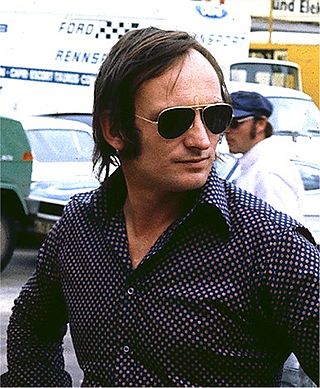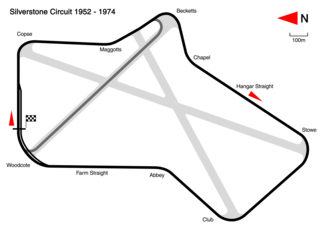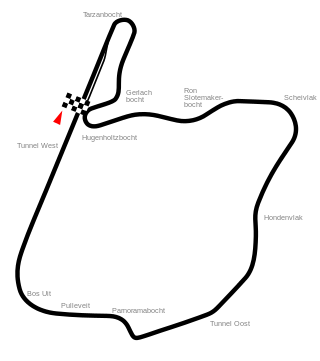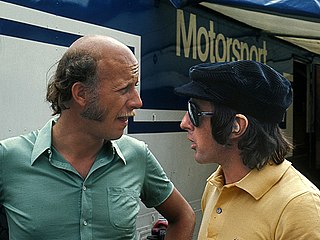
John Michael Hawthorn was a British racing driver. He became the United Kingdom's first Formula One World Champion driver in 1958, whereupon he announced his retirement, having been profoundly affected by the death of his teammate and friend Peter Collins two months earlier in the 1958 German Grand Prix. He died in a road accident three months after retiring.

Christopher Arthur Amon was a New Zealand motor racing driver. He was active in Formula One racing in the 1960s and 1970s, and is widely regarded as one of the best F1 drivers never to win a championship Grand Prix. His reputation for bad luck was such that fellow driver Mario Andretti once joked that "if he became an undertaker, people would stop dying". Former Ferrari Technical Director Mauro Forghieri stated that Amon was "by far the best test driver I have ever worked with. He had all the qualities to be a World Champion but bad luck just wouldn't let him be".

The 1973 Grand Prix of Sweden was a Formula One motor race held at the Scandinavian Raceway, Anderstorp on 17 June 1973. It was race 7 of 15 in both the 1973 World Championship of Drivers and the 1973 International Cup for Formula One Manufacturers. The 80-lap race was won by McLaren driver Denny Hulme after he started from sixth position. Ronnie Peterson finished second for the Lotus team and Tyrrell driver François Cevert came in third.

The 1973 British Grand Prix was a Formula One (F1) motor race held at Silverstone on 14 July 1973. It was race 9 of 15 in both the 1973 World Championship of Drivers and the 1973 International Cup for Formula One Manufacturers. The race is known for the first lap pile-up, which ultimately caused eleven cars to retire. The accident happened when Jody Scheckter, running fourth in his McLaren, spun across the track at Woodcote Corner at the end of the first lap, causing many other cars to collide and crash. The incident eliminated nine cars, including all three works Surtees cars, while Brabham driver Andrea de Adamich suffered a broken ankle that ended his F1 career. The race was stopped at the end of the second lap, before being restarted over the original 67-lap distance with 18 of the original 29 cars. David Purley and Graham McRae had retired in separate incidents.

The 1973 Dutch Grand Prix was a Formula One motor race held at Zandvoort on 29 July 1973. It was race 10 of 15 in both the 1973 World Championship of Drivers and the 1973 International Cup for Formula One Manufacturers. Zandvoort returned to the Formula One calendar following a year's absence for extensive safety upgrades to the race track including new asphalt, new barriers and a new race control tower. Jackie Stewart won the race, this Grand Prix being fourth of five wins for Stewart during the 1973 Formula One season, and he became the most successful Formula One driver of all time with his 26th Grand Prix victory, surpassing Jim Clark's record of 25 victories. Stewart's friend and future world champion James Hunt scored his first podium finish.

The 1977 British Grand Prix was a Formula One motor race held at Silverstone on 16 July 1977. It was the tenth race of the 1977 World Championship of F1 Drivers and the 1977 International Cup for F1 Constructors.

The 1973 Formula One season was the 27th season of FIA Formula One motor racing. It featured the 1973 World Championship of Drivers and the 1973 International Cup for F1 Manufacturers, which were contested concurrently over a fifteen-race series that commenced on 28 January and ended on 7 October. The season also included two non-championship races which were open to both Formula One and Formula 5000 cars.

The Dutch Grand Prix is an annual Formula One World Championship auto racing event, held at Circuit Zandvoort, North Holland, the Netherlands, from 1950 through 1985, and after a 35 year hiatus, from 2021 onwards.

Arturo Francesco "Art" Merzario is a racing driver from Italy. He participated in 85 Formula One World Championship Grands Prix, debuting at the 1972 British Grand Prix. He scored 11 championship points.

Henri Jacques William Pescarolo is a former racing driver from France. He competed in the 24 Hours of Le Mans a record 33 times, winning on four occasions, and won a number of other major sports car events including the 24 Hours of Daytona. He also participated in 64 Formula One World Championship Grands Prix, achieving one podium and 12 championship points. Pescarolo also drove in the Dakar Rally in the 1990s, before retiring from racing at the age of 57. In 2000 he set up his eponymous racing team, Pescarolo Sport, which competed in Le Mans until 2013. He wore a distinctive green helmet, and wears a full-face beard that partially covers burns suffered in a crash.

Keith Jack Oliver is a British former Formula One driver and team-owner from England. He became known as the founder of the Arrows team as well as a racing driver, although during his driving career he won both the 24 Hours of Le Mans race and the Can-Am championship. Oliver was also the second person to complete the informal triple Crown of endurance racing.
Charles Anthony Standish Brooks was a British racing driver. Also known as the "Racing Dentist", he participated in 39 Formula One World Championship Grands Prix, competing for the first time on 14 July 1956, and achieved six wins, 10 podium finishes and 75 career points. He was third in the World Drivers' Championship in 1958 with Vanwall and second in 1959 with Ferrari. He also scored the first win by a British driver in a British car in a Grand Prix since 1923, driving a Connaught at Syracuse in 1955 in a non-championship race. After the death of Stirling Moss in 2020 and before his own death in 2022, Brooks was the last surviving Grand Prix winner from the 1950s.
Connew Racing Team, commonly known as Connew, was a short lived British Formula One constructor. Founded in 1971 by Peter Connew, the team constructed a single car, the PC1. The first monococque had to be aborted due to a change in regulations and the second tub was known as PC2. However, record books show the car driven by Migault and others as PC1. The intent was to compete in the Formula One World Championship in 1972, but a lack of financial and technical resources meant that the car only managed to start in one championship race, the 1972 Austrian Grand Prix, with French driver François Migault at the wheel. Following the Austrian race, the car competed in a handful of non-championship races before being converted to meet Formula 5000 specifications for the 1973 season. The chassis was damaged beyond repair during the season finale at Brands Hatch and the team closed.

Roger Williamson was a British racing driver and a two time British Formula 3 champion, who died during his second Formula One race, the 1973 Dutch Grand Prix at Zandvoort Circuit in the Netherlands.

David Charles Purley, GM was a British racing driver born in Bognor Regis, West Sussex, who participated in 11 Formula One World Championship Grands Prix, debuting at Monaco in 1973.
Pilbeam Racing Designs is a British company which designs and constructs racing cars, based in the Lincolnshire town of Bourne. The company was founded in 1975 by Mike Pilbeam.

Frederick Bernard "Tom" Wheatcroft was an English businessman and car collector. He made his fortune through building and construction, and was known for resurrecting the Donington Park motor racing circuit and founding the Donington Grand Prix Collection museum.
Michael Roy Pilbeam is a British motorsport designer and engineer known for his work with BRM, Lotus, Surtees and his own company, Pilbeam Racing Designs. An early design was the experimental four wheel drive Formula One BRM P67 of 1964. As of 2014, Pilbeam's company continued to produce hillclimb cars and sports prototype chassis for endurance racing.

The Williams FW was a Formula One car used by Frank Williams Racing Cars during the 1973, 1974 and 1975 seasons. It was designed by John Clarke.

The Penske PC1 was a Formula One racing car developed and raced by Penske Racing during the 1974 and 1975 Formula One seasons. The car was designed by Geoff Ferris, and was raced by drivers Mark Donohue and John Watson. The PC1 entered and competed in 12 Grands Prix, and was replaced by the Penske PC3 in the 1976 season.

















